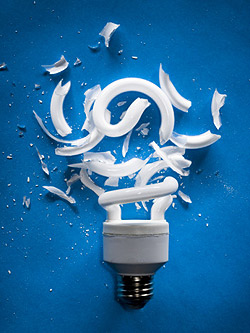Since white LEDs have swamped the pages of Electrical websites over the last year (coincidentally since legislation was introduced in many countries forcing people to change from incandescent lamps to CFLs), by reason of projected long life and low energy input, perhaps a better solution would be to now ban CFLs and force everyone to use LEDs?
Blog Post
EPA offers guidelines for broken CFLs, but will we follow them?

While CFLs have become more popular and less expensive in recent years, they still enjoy only around a quarter of the total market share for residential light bulbs--perhaps in part because of exaggerated reports about mercury toxicity and the difficulty of cleanup and disposal, some of which have prompted debunking sites like Snopes.com to clear the air. The average bulb contains around 5 mg of mercury, about 100 times less than an old-fashioned oral thermometer.
Still, mercury in any quantity should not be taken lightly, particularly in a home where children or pets live. Mercury in fish and other foods is a serious issue, but mercury vapor is even more toxic. Ingested mercury is not well absorbed by the body, while in contrast, inhaled mercury enters the bloodstream readily.
The new guidelines
The new EPA guidelines focus on preventing mercury inhalation. The key steps to safely cleaning up a CFL include the following.
- Remove all people and pets from the room where the bulb broke
- Ventilate the room by opening a window for a few minutes
- Shut off central air conditioning or heating, for several hours if possible
- Avoid vacuuming in a mercury-contaminated area
- Pick up fragments with cardboard rather than a vacuum cleaner
- Pick up remnants with tape
- Seal all debris inside a glass jar (since plastic bags will not prevent mercury vapor from escaping)
- Store sealed glass jar outside the home
- Open windows and turn off central climate control the next few times you vacuum the room
- Check with local waste disposal authorities about how to dispose of all CFLs, whether broken or not
What are the risks?
SUPPORT INDEPENDENT SUSTAINABILITY REPORTING
BuildingGreen relies on our premium members, not on advertisers. Help make our work possible.
See membership options »The guidelines are intended to inform consumers of how to safely respond to a broken CFL. How much of a risk is really involved?
A working group opinion (PDF) accompanying the new release on the EPA website suggests that the miniscule amount of vaporized mercury from a single broken bulb is within the safe range for adults. Studies have measured the level of vapor shortly after a CFL breakage to be between 8 and 20 micrograms per cubic meter, and levels decline rapidly within a few minutes. To give some context, 100 micrograms per cubic meter is considered a safe level for long-term occupational exposure.
However, the scientists conclude that there is not enough data to make a similar evaluation regarding children--especially since children's behaviors are different from adults'--and a reliable risk assessment regarding children and broken CFLs is not currently available.
In the absence of evidence that short-term, low-level exposure is safe for all households, the EPA has provided guidelines that help consumers minimize that exposure until more is known.
Are guidelines like these helpful, or do they scare people so much they may not buy the bulbs? Alternately, are the guidelines so impractical that consumers may ignore them altogether?
I'm likely to send my kids out of the room in response to any broken glass, and I certainly won't invite them to play with quicksilver, the way I did in high school chemistry class. But it's January in Vermont, so opening a window and turning off the heat for several hours sounds extreme. Good thing we almost never need to replace our CFLs, so the likelihood of breakage is low.
Let us know what you think in the comments below.
Published January 3, 2011 Permalink Citation
(2011, January 3). EPA offers guidelines for broken CFLs, but will we follow them?. Retrieved from https://www.buildinggreen.com/news-article/epa-offers-guidelines-broken-cfls-will-we-follow-them
Comments
I agree that for most people
I agree that for most people the broken glass is the biggest issue. I am trying to imagine a classroom-type situation, particularly a younger, elementary class. I don't think the teacher or custodian is going to take the time to look up the reccomended guidlines. They are going to use whatever tools are fastest and easiest (i.e. dustpan and vacuum), and likely not even remember what room it happened in the next time they clean. For better or worse, I think this is another example of "best practice" vs. "common practice".



Add new comment
To post a comment, you need to register for a BuildingGreen Basic membership (free) or login to your existing profile.